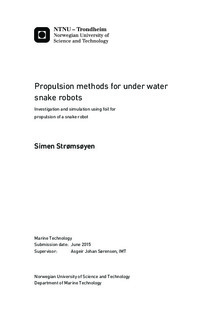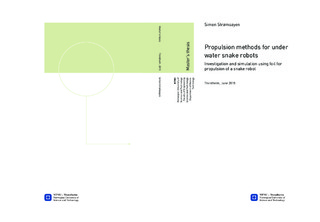| dc.contributor.advisor | Sørensen, Asgeir Johan | |
| dc.contributor.author | Strømsøyen, Simen | |
| dc.date.accessioned | 2015-10-05T15:04:26Z | |
| dc.date.available | 2015-10-05T15:04:26Z | |
| dc.date.created | 2015-06-09 | |
| dc.date.issued | 2015 | |
| dc.identifier | ntnudaim:12937 | |
| dc.identifier.uri | http://hdl.handle.net/11250/2350804 | |
| dc.description.abstract | In this thesis we present a model of a swimming underwater snake robot. How aquatic animals move in water has fascinated people for decades. NTNU started the research on land based snake robots 11 years ago. The last years also underwater snake robots has become a topic. This thesis is based on this research.
In this study an extension of the underwater snake model moving in a 2D plane presented in [1] is derived. The new model makes it possible to include an extra propulsion force in each link. In the new model each link can also have different mass, length and inertia. The new model is implemented in Matlab R2014b. The simulations show that the new model gives the same answers as the one proposed in [1].
Further more a quasi-steady model for a oscillating and rotating foil are combined on the new extended underwater snake robot model to simulate a snake with a high aspect ratio caudal fin. Simulation with and without the caudal fin are presented. Results show an increase in speed for both eel and snake like motion. More simulations for the eel-like motion were carried out. This shows a significantly reduction in the work per meter for the underwater snake robot with tail at the same forward velocities. The results also shows that the use of a quasi-steady foil model acceptable. The KC numbers are plotted for 3 different links for the eel motion with caudal fin. This shows a significantly difference in the KC number which motivates for the investigation of using different drag coefficients for the different links.
The effect of a dorsal fin is also investigated. The simulations were done with a caudal fin and a dorsal fin at the fifth link. The results show a decrease of work per meter and an increase of the efficiency for the same simulation parameters. The sideways motion of the center of mass was slightly damp due to the dorsal fin.
The complexity of underwater snake robots makes it challenging to model and there are still a lot of work to be done. Making a maneuvering and transit controller for the underwater snake robot and prove stability is something too continues with. Future control of the tail and angel for attack and optimization of the movements is also necessary. The interaction effects between the snake, caudal fin and dorsal fin could also increase the efficiency for the robot. | |
| dc.language | eng | |
| dc.publisher | NTNU | |
| dc.subject | Marin teknikk, Marin kybernetikk | |
| dc.title | Propulsion methods for under water snake robots - Investigation and simulation using foil for propulsion of a snake robot | |
| dc.type | Master thesis | |
| dc.source.pagenumber | 120 | |

